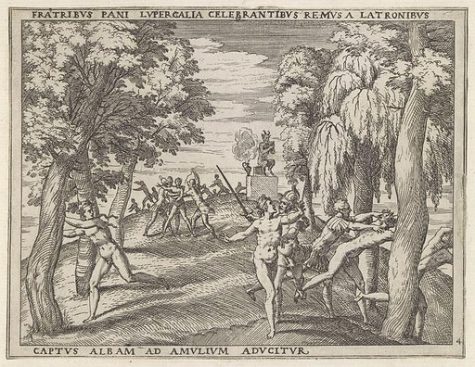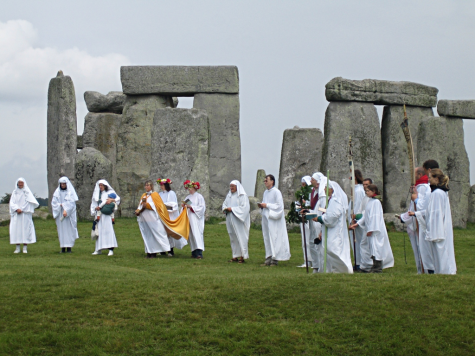The Development of a Holiday
What are the origins of Valentine’s, Easter, and Halloween, and how have they evolved into the holidays they are now.
May 18, 2022
The most common religion throughout both the western world and the whole world is Christianity; however, many Christian beliefs and practices were present in other cultures and religions. Which makes the question, “How deep are the roots of paganism in Christianity?”
Valentine’s Day—although considered by many to be non-religious, has deep religious ties. Valentine’s Day, also called “St. Valentine’s Day,” was named after St. Valentine; however, little is known about him. In fact, no one is quite sure who St. Valentine was. What we do know about him though, is that he was buried on the Via Flaminia in Rome, on February 14th, 269 CE, which is where we get the date for Valentine’s Day. It wasn’t until 496 CE that the official date for Valentine’s Day was established, when Pope Gelasius added St. Valentine of Rome to the Calendar of Saints.
Before any such Christian attribution, February 14th coincided with the Roman pagan celebrations of Lupercalia, which was celebrated from the 13th to the 15th of February. Lupercalia was a holiday charged with sexual activity and animal sacrifice, hoping to ward off infertility. It was a holiday in association with the Roman god, Lupercus; however, Lupercalia is much older than Rome itself. Lupercalia actually has some links to the Ancient Greeks, who celebrated their own god, Pan. Both Pan and Lupercus were gods who were linked to human and flock animal fertility, notably sheep. ‘Coincidentally,’ Lupercalia was officially condemned by Pope Galasius, the same person who established Valentine’s Day.
Nowadays, many religious groups don’t have much of a stance on Valentine’s Day, including the Christians who established it. Junior at GCHS, and a member of the Church of Latter-Day Saints, Estreya Ortegon, only considers it as, “just another day… like Presidents day. There’s no stance on it in my church.” Although Mormons were not the ones to create Valentine’s Day, it’s interesting that none of the top 4 Churches in the United States (Catholics, Baptists, Methodists, and Mormons) honor the ‘religious history’ of Valentine’s Day.

Easter is one of the most important and oldest Christian Holidays, celebrating the resurrection of Jesus Christ. Although some people still celebrate the religious aspect of Easter, many people just strictly celebrate the holiday with Easter eggs, bunnies, baskets and candies. Some individuals also partake in Easter parties, such as Sophia Monsevais, a junior at GCHS. While Sophia “[isn’t a huge fan] of holidays, [her] mom’s boyfriend [has] 10 different families that [all] come together” to celebrate Easter. With so many people who celebrate the holiday, it’s shocking that not many people actually know the origins of the Easter Bunny nor Easter Eggs, let alone why a bunny ‘hides’ them.
Most historians have accepted the origins of Easter coming from the English/Germanic pagan goddess, Ēostre (pronounced “yow-str”). This idea came from “The Father of English History,” an English Monk named Bede. According to Bede, the Christian church took the name of the pagan goddess, and gave it a new meaning. The only problem is that this idea only has one source. A single writing. By one person… Bede. It’s also speculated that Ēostre might have liked eggs and bunnies, there’s not much evidence to support this.
For centuries, Orthodox Christians in Mesopotamia have been dying eggs red to symbolize Jesus Christ’s death. Additionally, the Christian church also began a practice of abstaining from eating eggs during Lent (a 40-day season of prayer, fasting, and almsgiving). Once Easter came around, Christians were allowed to eat eggs again, so hiding decorated eggs became a way of celebration and feasting. Nowadays, eggs are very readily available, and the abstinence from eggs is no longer a key feature of lent, so instead of eating actual eggs, many of us instead hide candy in plastic eggs. The origin of the Easter Bunny is a lot more fun though. The commonly accepted history is that German Lutherans invented the tradition of the rabbit at Easter, originally describing the bunny as a judge-like figure who hid eggs for well-behaved children.
Halloween; also known as “All Hallows Eve,” is hardly ever celebrated as a religious holiday. Estreya who takes it as “just a fun holiday to dress up” and Sophia, who goes a step further by “trying to dress up as scary as [possible] to scare little kids,” both celebrate Halloween as the modern Holiday it has evolved into. Originally, All Hallows Eve was intended by the Christian Church to be a day of vigil for the next day, which celebrated all of the holy saints and martyrs. Interestingly, Halloween coincides with the Celtic pagan celebration of Samhain, which began at sunset on October 31st. Samhain meant “summer’s end” and was at the beginning of “the dark season,” a time when spirits of deceased family members and ancestors were welcomed into homes. Samhain was traditionally celebrated by playing games, some of which were said to foretell the future. Traditions also included bobbing for apples, and roasting nuts on a fire, the ashes of which were used for telling fortunes.
The invention of Halloween was meant to curb the pagan practices of superstition and fortune-telling, but had little success. By the 16th century, the festivities included guising, where people would call on neighbors while disguised to receive gifts of foods and drinks, which is where we get the tradition of Trick-or-Treating. Carving pumpkins and Jack o’Lanterns were also pagan practices that came from the Druids, members of a high-ranking class in Ancient Celtic cultures.

Christianity has taken and incorporated many traditions from different cultures and religions. With the amount of information at our fingertips, many people—no matter their religious position, would have a lot to gain from learning about other religions, cultures, and traditions. Many things mentioned in this article are not common knowledge and are definitely not taught at school, nor most religious temples, and with so much information being lost to time, there is so much more to discover. Learning about history can be quite enjoyable if you hold an interest in the research subject. With numerous different religions and cultures, it’s almost guaranteed that one of them will pique your interest.






























